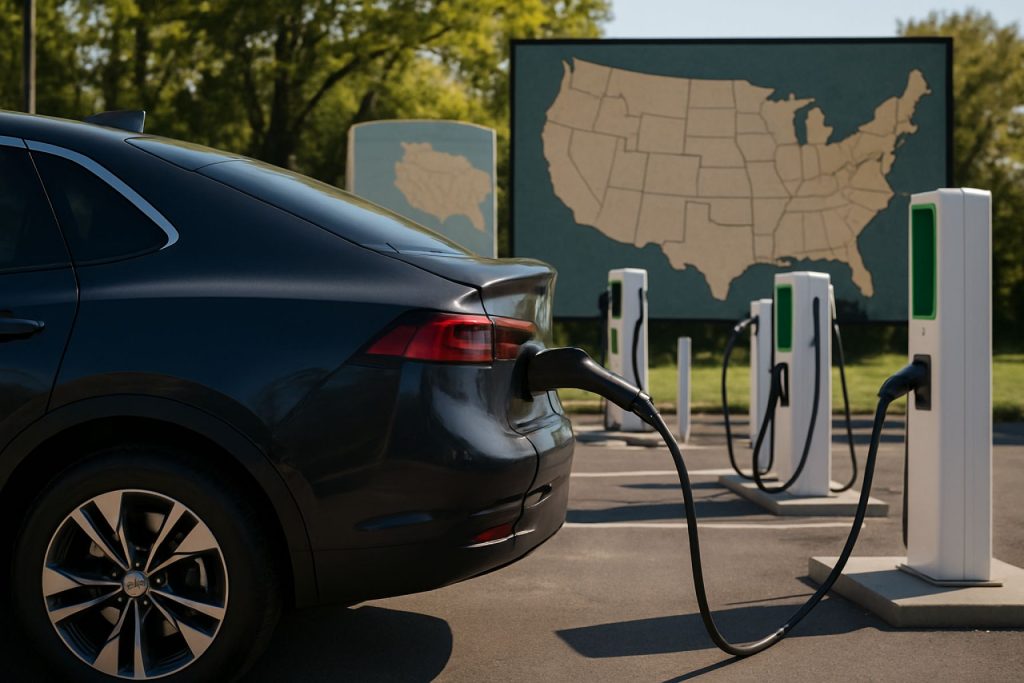
- Electric vehicle infrastructure is expanding rapidly but unevenly across the U.S., with over 192,000 public charging ports and significant disparities between states.
- Reaching national goals—500,000 charging stations by 2026 and 2 million by 2030—will require faster investment and broader policy support.
- States leading the charge, like Delaware, Washington, DC, and New York, combine strong policy incentives, high-power chargers, and smart charger placement.
- The Northeast and Nevada exemplify how proactive funding and public-private partnerships accelerate EV adoption and access.
- Regions lagging behind, such as Alaska and parts of the Midwest and South, suffer from limited government incentives and sparse infrastructure, hindering progress.
- The future of electric mobility depends on sustained investment, robust policy, and ensuring that reliable charging is accessible to all Americans.
Electric vehicles are humming down America’s highways in record numbers, promising a cleaner future and rewriting the rules for car ownership. But beneath the surface of this electrified revolution, a striking divide stretches across the map: some states are cruising ahead with powerful charging networks, while others are stuck in the slow lane, leaving eco-conscious drivers stranded in charging deserts.
This national race isn’t just about numbers—it’s about speed, access, and the boldness to invest in tomorrow. The U.S. now boasts more than 192,000 public charging ports, adding roughly 1,000 new ones each week. Yet, the White House’s ambitious milestone of half a million stations by 2026 looks increasingly distant, and experts at the National Renewable Energy Laboratory see a demand for over two million by 2030 as new, affordable models from companies like BYD push EV adoption higher.
How do states stack up against these looming challenges? The answer lies in the HERE-SBD EV Index, a potent metric that weighs not just the raw quantity of chargers but their power, distribution, and market adoption. The data reveals an unexpected leaderboard.
Delaware, a small but nimble state, clinches the top spot—turning its compact geography into an advantage, with high-power chargers spaced smartly across its network. The nation’s capital, Washington, DC, emerges as a model for public-private cooperation, offering generous tax rebates and utility programs that cover installation costs, making charging accessible and affordable for city dwellers. And New York underscores the critical impact of targeted incentives, maintaining robust programs tailored to a patchwork of communities.
Many of the top performers cluster in the Northeast—places like Massachusetts, Connecticut, and Rhode Island—leveraging policy innovation and public awareness. Out west, Nevada’s rapid build-out signals a readiness to support road trippers gliding past sun-baked desert landscapes.
But the divide is sharpest at the bottom of the list. Alaska’s vast wilderness is mirrored by its lackluster commitment to EV infrastructure, offering almost no public incentives. Arkansas, despite better charger coverage, offers meager rebates—just a fraction of the national average. Across much of the Midwest and South, limited funding and political will keep the charging revolution at bay.
The message could not be clearer: states that pair robust policy incentives with high-wattage, widely accessible chargers pull ahead. Where governments step up, private investment and consumer confidence follow. In fact, research shows that 56% of the country now offers rebates for residential charging installations, steadily easing pressure on public infrastructure.
Even as momentum builds, the U.S. finds itself at a crossroads. The growing wave of EV adoption—and rising competition from global giants—means that states can no longer afford to drag their heels. The path forward demands ambitious action: expanding incentives, scaling infrastructure, and ensuring every American, whether in a city high-rise or a rural farmhouse, can plug in to the future.
For those watching the pulse of American innovation, it’s not just about the next breakthrough car. It’s about whether the power behind this clean-energy transition will keep pace with demand—or whether the promise of the electric highway will stall just short of the horizon.
For deeper engagement with the latest in automotive innovation and premium car culture, visit Supercar Blondie. For broader updates on science, technology, and infrastructure, explore The New York Times and Bloomberg.
Key takeaway: States that are investing—smartly and boldly—reap the rewards of cleaner air, happier drivers, and a future that plugs in, not sputters out. The rest risk running on empty as the global electric revolution races ahead.
Revealed: The Surprising Truth Behind America’s Electric Vehicle Charging Race—Will Your State Win or Be Left Behind?
America’s EV Charging Divide: What You Need to Know (and Why It Matters More Than Ever)
America’s electric vehicle (EV) boom promises transformational change—but as public charging infrastructure lags and gaps widen across state lines, EV buyers and policymakers are facing pivotal choices. Here’s what the original article missed, plus the deeper facts, industry insights, actionable tips, and pressing questions that every potential EV owner and curious citizen ought to know.
—
The Real State of America’s Charging Network: 2024 Update
Beyond the Numbers: Types, Locations, and Quality
– The U.S. had over 192,000 public charging ports as of early 2024, but only about 38,000 are DC fast chargers (source: U.S. Department of Energy). Most are Level 2, which charge much slower.
– About 80% of charging happens at home (according to J.D. Power), making access to home installation rebates crucial.
– Urban areas (especially on the coasts) command a much denser network, leaving rural drivers and long-distance travelers at a disadvantage.
– High-power fast chargers are mainly concentrated on highways and major city corridors; many regions are still “charging deserts.”
Glossary Quick Guide:
– Level 1: Standard plug, 120V, adds 2–5 miles per hour—best for overnight home use.
– Level 2: 240V, adds 10–60 miles per hour—common for homes, workplaces, and many public locations.
– DC Fast Charging: 400V–900V, adds 150–400+ miles per hour—crucial for road trips.
States Leading the Way—And Why
– Delaware and Washington, DC benefit from geographic compactness and targeted incentives.
– California has the largest raw network (over 15,000 stations) but struggles with congestion and reliability.
– New York and Massachusetts invest heavily in both rebates and education.
– Nevada serves as a Western model, building long-range corridors geared for cross-country travel (source: NY Times).
States Struggling to Catch Up
– Alaska has fewer than 50 public charging points as of 2023.
– Arkansas and much of the Deep South/Midwest have limited financial incentives and slower infrastructure rollout (source: NREL).
—
Pressing Questions Answered—What Most EV Shoppers Ask
1. How much does it cost to install a home charger?
– National average: $700-$1,500 for Level 2. Rebates can bring this to under $500 in top-performing states.
– Check your local utility provider for additional savings (many offer extra rebates or discounted installation partnerships).
2. How much does public charging cost?
– Level 2: Typically $0.15–$0.40/kWh—translate to about $6–$15 for a full recharge.
– Fast charging: $0.25–$0.60/kWh. Tesla Superchargers (for non-Tesla vehicles) may carry extra fees.
– Apps like PlugShare, ChargePoint, or Electrify America can help map and compare stations, rates, and real-time status.
3. Which automakers provide free charging?
– Hyundai, Kia, Ford, BMW, and Mercedes-Benz have offered limited-time free fast charging deals to new buyers in partnership with networks like Electrify America and EVgo.
4. Are all EVs and chargers compatible?
– Most modern EVs in North America use the CCS (Combined Charging System) standard; Tesla uses its proprietary plug but has started opening its Supercharger network to non-Tesla EVs in select locations.
– Adapters are becoming available, but always check your vehicle’s charging port type.
—
How-To Guide: Maximizing Your EV Charging Experience
Step 1: Assess Your Home Charging Options
– Secure access to a personal or assigned parking space.
– Check your home’s electrical panel to ensure it supports Level 2 charging.
– Apply for local or utility rebates before installation.
Step 2: Plan Extended Trips
– Download recommended charging network apps.
– Map fast-charging stations along your expected route.
– Factor in extra charging stops in cold weather (battery range can drop up to 40%).
Step 3: Tap Into State and Federal Incentives
– Find out if your state offers rebates for EV purchases, charger installations, and even electricity rate discounts (see the U.S. Department of Energy Alternative Fuels Data Center for listings).
Step 4: Monitor Industry Trends
– New, more affordable EV models are coming from BYD, Hyundai, and GM, increasing adoption and pressuring infrastructure—expect market shifts as federal NEVI funds deploy.
—
EV Charging Market Forecasts & Industry Trends
– Growth: The U.S. public charging market is forecast to grow 30% annually through 2030, but adoption could outpace station availability without major investment (source: BloombergNEF).
– Private Investment: Oil majors (Shell, BP), utilities, and automakers (GM, Tesla) are investing billions in expanding fast-charging networks.
– Tech Upgrades: Wireless charging, bidirectional vehicle-to-grid (V2G), and AI-powered load balancing are on the horizon.
—
Reviews, Pros & Cons, and Controversies
Pros:
– Lower “fuel” costs per mile, reduced maintenance, and substantial emissions reduction.
– Generous incentives in top states can make EVs as affordable as ICE vehicles.
Cons:
– Inconsistent charger reliability and station downtime are major pain points (reported by J.D. Power and Consumer Reports).
– Rural and interstate routes remain challenging due to sparse coverage.
– Cold climates lower range and increase charging times.
Controversies:
– Equity Concerns: Renters and apartment dwellers have less access to home charging.
– Utility Load: Rapid EV adoption may challenge local electricity grids if not managed carefully (source: U.S. DOE).
—
Security, Sustainability, and Real-World Use Cases
– Network Security: Charging stations are potential cyberattack vectors; top networks employ encryption and periodic security audits.
– Sustainability: Most public charger installations are paired with renewable energy sourcing, but construction still produces a notable carbon footprint.
– Best For: Urban commuters, two-car families, garage owners, drivers in states with robust incentive programs.
—
Actionable Recommendations & Quick Tips
1. Research Local Incentives—Check your state/utility for home charging rebates before you buy an EV.
2. Test Public Chargers—Try local stations with a plug-in hybrid or rental EV before you commit, especially if you live outside a top-ranked state.
3. Join Rewards Programs—Networks often offer discounts or points for frequent users.
4. Advocate Locally—Contact your local representatives to push for expanded charging infrastructure and public funding.
5. Stay Updated—Follow industry news via credible publications like Bloomberg.
—
Fast-Track Your EV Journey Today
As America’s EV charging landscape rapidly evolves, proactive steps—education, strategic planning, and leveraging incentives—can help you ride the electrified wave instead of being left stranded. The state you call home can offer hidden advantages or pose unique hurdles: the best results come to those who research, adapt, and demand more from policymakers and networks. The electric highway is being built—will you claim your lane or get caught in the slow lane?
Explore more about cutting-edge cars and innovation at Supercar Blondie, or dive deeper into science, policy, and infrastructure at The New York Times.



